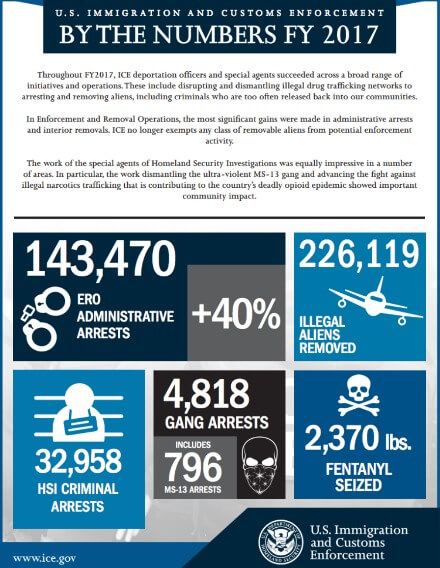Introduction
On December 5, 2017, the United States Immigration and Customs Enforcement (ICE) released a report on its year-end statistics for FY 2017 [PDF version]. The Department of Homeland Security (DHS) also discussed the ICE statistics in a broader report that also addressed U.S. Customs and Border Protection (CBP) statistics [PDF version]. In this article, we will examine the ICE statistics. To learn about the CBP statistics from FY 2017, please see our companion article [see article].
Overview
The ICE released a chart which contains general statistics from both its Enforcement and Removal Operations (ERO) and Homeland Security Investigations (HSI). We have embedded the chart as follows:
[Click image to view full size]
In this article, we will focus primarily on the ERO statistics.
Detailed Statistics from ICE
ICE reported that ERO made more than 143,000 administrative arrests in FY 2017 (October 1, 2016 — September 30, 2017). It stated that 110,568 of these arrests occurred after the inauguration of President Donald Trump on January 20, 2017. The 110,568 arrests from January 20, 2017 to September 30, 2017, marked a 42% increase from the same period in FY 2016. ICE stated that 92% of all aliens arrested by ERO in FY 2017 “had criminal convictions, pending criminal charges, were an immigration fugitive, or were an illegal re-entrant.”
ICE stated that interior removals increased significantly in FY 2017 from FY 2016. ICE removed 81,000 aliens from the interior. 61,000 of these removals occurred after January 20, 2017, marking an increase of 37% from the same period in FY 2016. Despite the increase in interior removals, ICE noted, overall removals declined slightly due to the “historic low in CBP border apprehensions…”
ICE attributed the increase in arrests and interior removals to the new immigration enforcement priorities issued by President Donald Trump [see article] and clarified by then-Secretary of Homeland Security John Kelly [see article].
ICE added that there has been a decrease in the number of countries that do not cooperate in the return of their nationals. In April 2017, there were 12 such countries, but the number was reduced to nine by the end of FY 2017. We discussed this issue in brief in an article on sanctions imposed on four countries for recalcitrance in accepting the return of nationals [see article]. ICE added that the number of countries at risk of being labeled uncooperative also decreased from 47 to 36 during FY 2017.
Although HSI is not immigration enforcement, it is worth noting that ICE stated that there were nearly 800 MS-13 gang-related arrests in FY 2017. This marked at 83% increase over the previous year. However, it does not specify how many of the MS-13 members were aliens. The DHS noted that, in total, ERO administratively arrested 5,225 gang members and associates in FY 2017, while HSI made 4,818 criminal arrests related to gang activity.
Conclusion
ICE reported increases in administrative arrests and removals from the interior. This news is unsurprising in light of the new enforcement priorities affording ICE more discretion in enforcing the immigration laws than did the priorities of the Obama Administration [see article on old priorities]. Going forward, it will be important for ICE to effectively enforce the immigration laws, while ensuring that it does so in a manner consistent with the rights of aliens in the United States.






